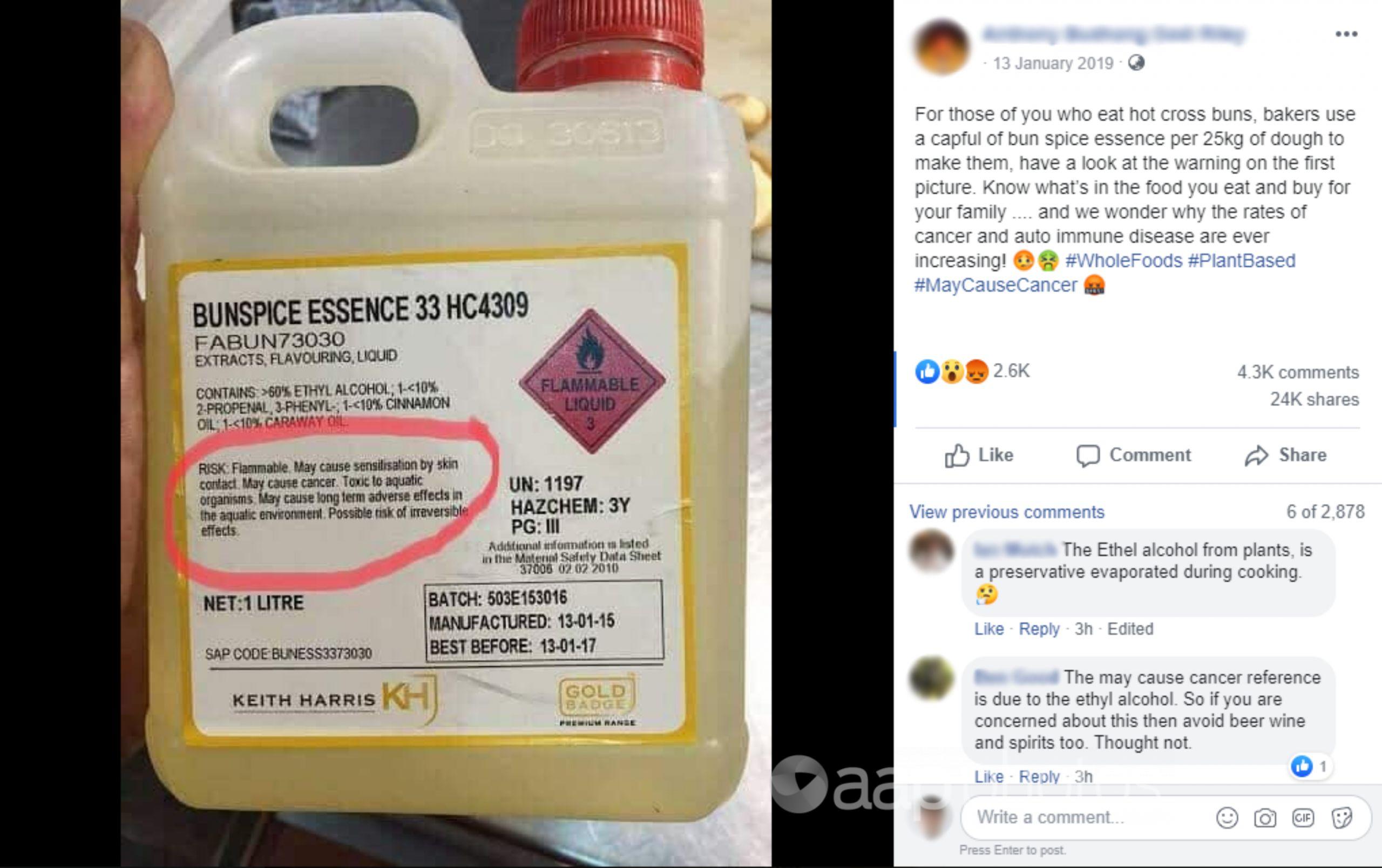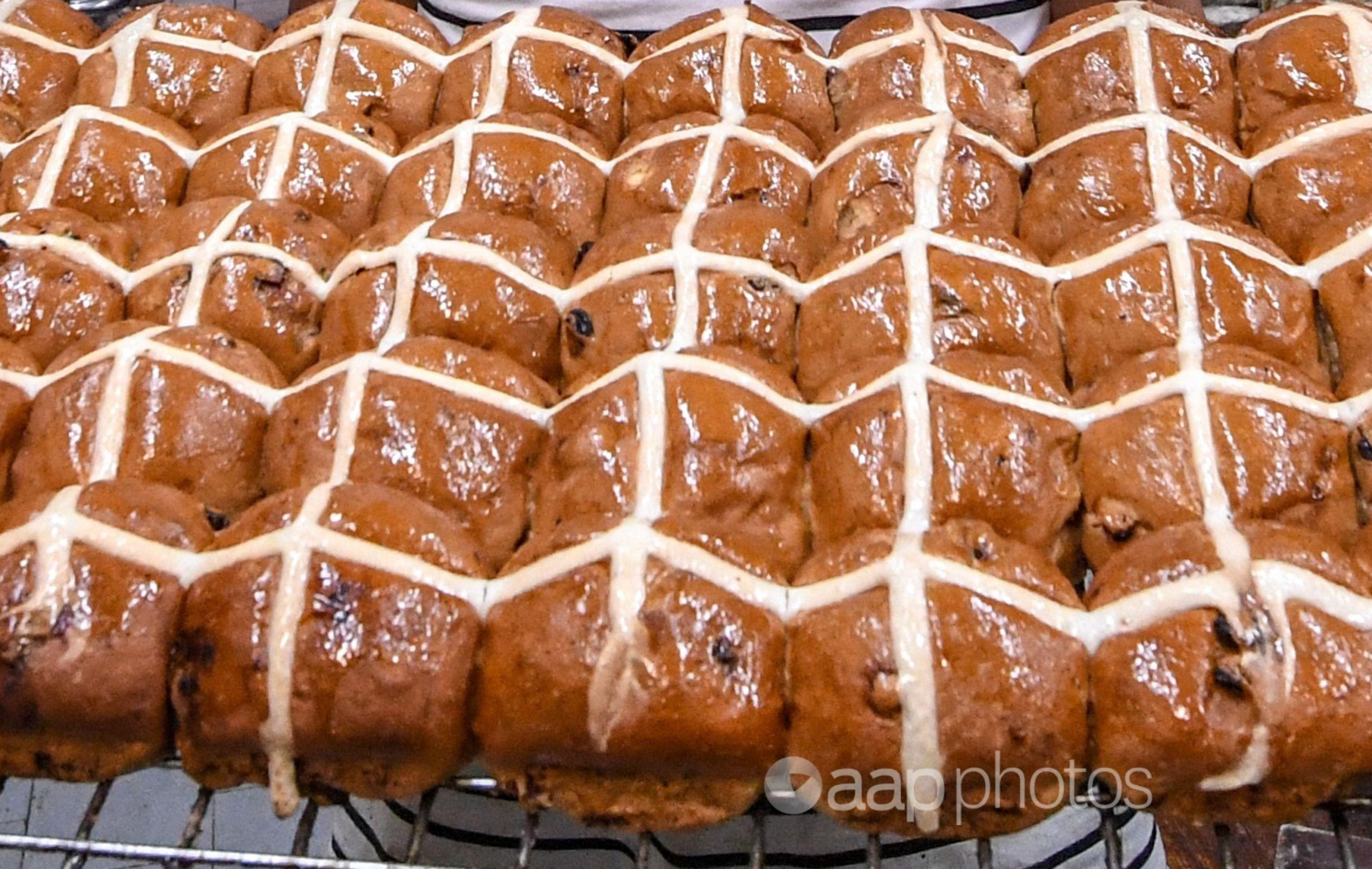The Statement
Hot cross buns, those Easter-time treats that appear in supermarkets not long after Christmas, are the subject of a viral social media post that raises fears that an ingredient in the buns may cause cancer or other health issues.
A Facebook post from January 13, 2019 features an image of a bottle labelled Bunspice Essence 33 HC4309. A red circle highlights the product’s ‘Risk’ list which includes: “May cause sensitisation by skin contact”, “may cause cancer”, and “toxic to aquatic organisms”.
The post’s caption reads, “For those of you who eat hot cross buns, bakers use a capful of bunspice essence per 25kg of dough to make them, have a look at the warning on the first picture. Know what’s in the food you eat and buy for your family …. and we wonder why the rates of cancer and auto immune (sic) disease are ever increasing! ?? #WholeFoods #PlantBased #MayCauseCancer ?.”
The post has been viewed more than 650,000 times and attracted more than 25,000 shares, 4,300 comments and 2,600 reactions.

The Analysis
A similar post about hot cross bun ingredients, featuring the same image, has circulated on Facebook since at least March 2016.
University of New South Wales food safety expert Julian Cox told AAP FactCheck the post takes the safety warnings out of context because they apply to the contents of the bottle rather than an amount used in a food product.
“The first part says it contains greater than 60 per cent ethyl alcohol, so basically normal ethanol,” Associate Professor Cox said.
“Even ethanol itself consumed directly in high amounts, as we know, can be toxic.
“If you were to drink that bunspice essence directly from the bottle, the ethanol itself could create acute or chronic health effects.”
“The point is the labelling on that is intended to represent safety warnings and risk around the products in that bottle, not about its end use.”
Associate Professor Cox told AAP FactCheck a person would have to eat “hundreds of hot cross buns” made with the bun spice essence in one sitting to actually see a toxic effect.
A spokesperson for IXOM, the parent organisation of the Keith Harris company which produces the bunspice essence, told AAP FactCheck the warning on the label related to the use of cinnamon oil in the bun spice essence and drinking the product straight or consuming it in copious quantities.
“One of the spices used in bun spice is cinnamon oil … which is naturally occurring, however levels are monitored due to a component it naturally contains,” the spokesperson said.
“For this reason, any ingredients using a certain amount of cinnamon oil needs a health warning. It’s Australian law and food regulations.”
According to the US Department of Health and Human Services, cinnamon contains safrole, a substance that is “reasonably anticipated to be a human carcinogen” based on the results of animal studies.
The department also states it found no studies linking “human cancer and exposure specifically to safrole”.
The IXOM spokesperson told AAP FactCheck the “May cause cancer’ warning on the label was required by Safe Work Australia due to the presence of safrole, which the regulatory body lists as a hazardous chemical.
IXOM’s spokesperson said the bunspice essence formulation was changed in 2016, reducing the cinnamon oil to a low level that does not require a warning. The label on the bottle in the Facebook post states the date of manufacture as January 13, 2015.
The spokesperson said a kilogram of hot cross buns would contain about half a millilitre of cinnamon oil.
“You would need to eat tonnes of hot cross buns on a regular basis for any ill effects.”
Cinnamon, especially Cassia cinnamon, also contains a compound called coumarin which, if consumed in large amounts, might cause or worsen liver disease, according to the US National Centre for Complementary and Integrative Health (NCCIH).
The NCCIH said in most cases, cassia cinnamon doesn’t have enough coumarin to make people sick.
Supermarkets Coles and ALDI responded to customers’ questions in 2016 saying their hot cross buns did not include bunspice essence 33 HC4309 as an ingredient.
Brumby’s Bakery and a Baker’s Delight franchise in Ulladulla, NSW confirmed they did use bunspice essence in their hot cross buns.
Brumby’s stated they do use a small amount of essence but said “the essence we use contains no ingredients identified as carcinogenic”.
Baker’s Delight Ulladulla said they use a small amount of bunspice essence in their bun wash mix as a flavour enhancer.
“Bakers Delight Holdings are committed to food safety and as such maintain a strict Approved Supplier Program. All ingredients must comply with the Food Standards Australia and New Zealand (FSANZ) Food Standards Code,” the company said in its March, 2016 response to a question on Facebook.
In 2019, ABC News covered a similar claim in a news article and found it to be misleading.
The Verdict
Based on the evidence, AAP FactCheck found the Facebook post to be misleading. There is no evidence or warning that says eating a small number of hot cross buns containing bunspice essence will cause health issues. The warnings on the bunspice essence bottle pictured relate to potentially directly drinking the bun spice essence or, according to a food safety expert, eating “hundreds” of buns in a single sitting.
Partly False – The claim of the content is a mixture of accurate and inaccurate, or the primary claim is misleading or incomplete.
* AAP FactCheck is accredited by the Poynter Institute’s International Fact-Checking Network, which promotes best practice through a stringent and transparent Code of Principles. https://factcheck.aap.com.au/
All information, text and images included on the AAP Websites is for personal use only and may not be re-written, copied, re-sold or re-distributed, framed, linked, shared onto social media or otherwise used whether for compensation of any kind or not, unless you have the prior written permission of AAP. For more information, please refer to our standard terms and conditions.


















